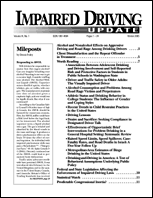DWI/DUI Arrests, BAC at the Time of Arrest, and Offender Assessment Test Results for Alcohol Problems
Author: Donald D. Davignon, Ph.D..
Source: Volume 06, Number 01, Winter 2002 , pp.5-7(3)

< previous article |next article > |return to table of contents
Abstract:
The following is a two-part article discussing the results of a study of the reliability of the Driver Risk Inventory-II (DRIII), a risk assessment tool. Of the 11,832 DUI/DWI offenders studied, 30.6% had two or more DUI/DWI arrests. DRI-II scales had high reliability (coefficient alphas at or above 0.90), proven validity (nearly 100% correct identification of problem drinkers) and accuracy to within 2% of predicted risk range percentages. The average BAC of multiple offenders was 0.158% and the average BAC for first offenders was 0.145%. The offenders’ number of DUI/DWI arrests was found to be highly correlated with their DRI-II Alcohol Scale scores. The correlation between BAC level and Alcohol Scale scores was found to be much lower. Part I, below, stresses the need for further research to discover ways to reduce drinking and driving beyond punitive measures, the effectiveness of which diminish over time. Remedial measures are also necessary. Because DUI/DWI offenders vary widely in terms of alcohol abuse, personality, and attitudes, the author argues that these tests must be more than just alcohol and drug tests. This article asserts that assessment tests, such as the DRIII, are essential to determine an offender’s risk and treatment needs, and to select appropriate intervention programs.Keywords: National Highway Traffic Safety Administration; Blood Alcohol Concentration (BAC); DUI/DWI; National Commission Against Drunk Driving; DRI-II;
Affiliations:
1: Behavior Data Systems, Ltd..